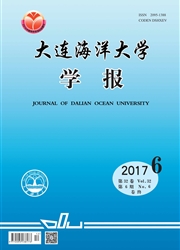

 中文摘要:
中文摘要:
将用凝石胶凝材料制作的水灰比为0.60、0.55、0.49、0.44的4种凝石供试体和相同水灰比的4种水泥供试体同时投放到同一海域中进行150 d的生物附着对比试验,每隔30 d观察并测定1次供试体表面附着生物的种类和生物量。结果表明:1)投放第30天时,凝石供试体与水泥供试体均无生物附着;第60天、第90天、第120天时,两种供试体表面附着生物的种类相同,均为10种;第150天时,两种供试体表面附着生物的种类相同,均为13种,主要有孔石莼Ulva pertusa、刺参Apostichopus japonicus、虾夷马粪海胆Strongylocentrotus intermedius、矮拟帽贝Patelloida pygmaea等。2)投放第60天和第90天时,凝石供试体附着生物总量低于水泥供试体,但第90天时,凝石供试体附着生物量的增加速度明显快于水泥供试体;第120天时,凝石供试体附着生物总量已超过水泥供试体;第150天时,凝石供试体附着生物量平均值为344.85 g/cm2,水泥供试体附着生物量平均值为260.15 g/cm2,凝石组明显高于水泥组。3)投放第150天时,4种水灰比的凝石供试体附着生物量平均值分别为58.63、79.32、89.66、117.25 g/cm2,可见在试验范围内,凝石供试体表面附着生物量随着水灰比的降低即凝石胶凝材料含量的增加而增大。试验表明,凝石胶凝材料作为人工鱼礁的造礁材料在生物附着方面比水泥具有优越性,因而凝石胶凝材料作为人工鱼礁造礁材料具有实用性。
 英文摘要:
英文摘要:
Four kinds of modules prepared by congealing stone material at a water cement ratio of 0.60,0.55,0.49,and 0.44 were displaced in the same area for 150 days and the species composition and biomass of organisms attached to surface of the tested modules were monitored in a 30 day interval.The results showed that:1)No organisms were found to be attached to the tested modules on the 30th day.The same species(about 10 species) of the organisms attached to the surface of the tested modules were observed on the 60th day,90th day,and 120th day.On the 150th day,there were 13 species on the surface of the two tested modules,including sea weed Ulva pertusa,sea cucumber Apostichopus japonicus,sea urchin Strongylocentrotus intermedius,and clam Patelloida pygmaea.2) On the 60th day and 90th day,there were lower biomass attached to the congealing stone tested modules than on the cement tested modules,even though on the 90th day.The biomass showed more rapid increase on the congealing stone tested modules than those on the cement tested modules.On the 120th day,however,the biomass on the congealing stone tested modules had more than on the cement tested modules,averaging 344.85 g/cm2 on the congealing stone tested modules,significantly higher than that on the cement group(260.15 g/cm2) on the 150th days.3) On the 150th day,there were biomass of 58.63,79.32,89.66,117.25 g/cm2 on the four kinds of water cement ratio in the congealing stone tested modules,indicating that in the experiment the biomass attached to the tested module surfaces was increased with the decrease in water cement ratio.These findings suggested that the congealing stone material as artificial reefs in biological attachment had the superiority to the cement reefs.
 同期刊论文项目
同期刊论文项目
 同项目期刊论文
同项目期刊论文
 期刊信息
期刊信息
